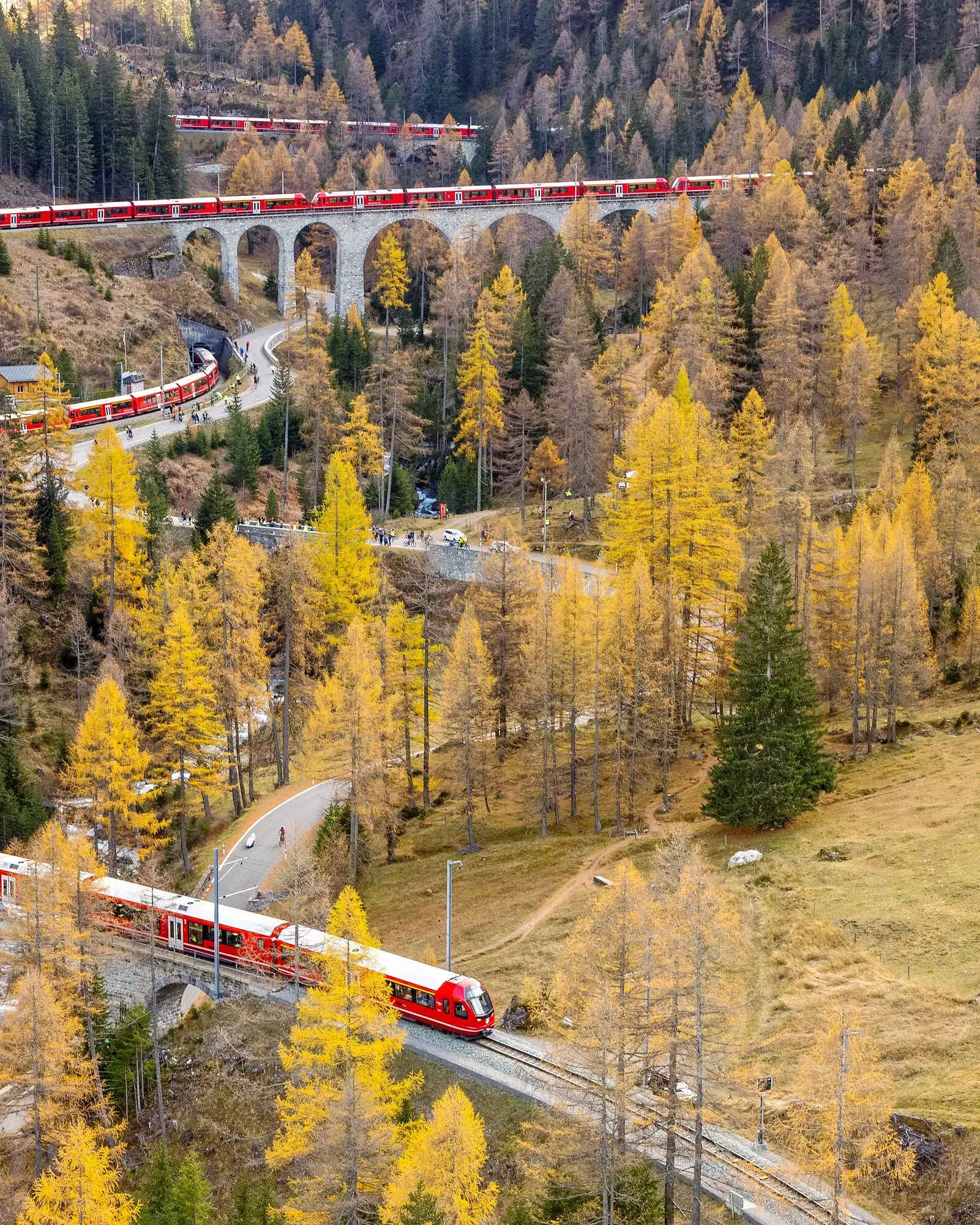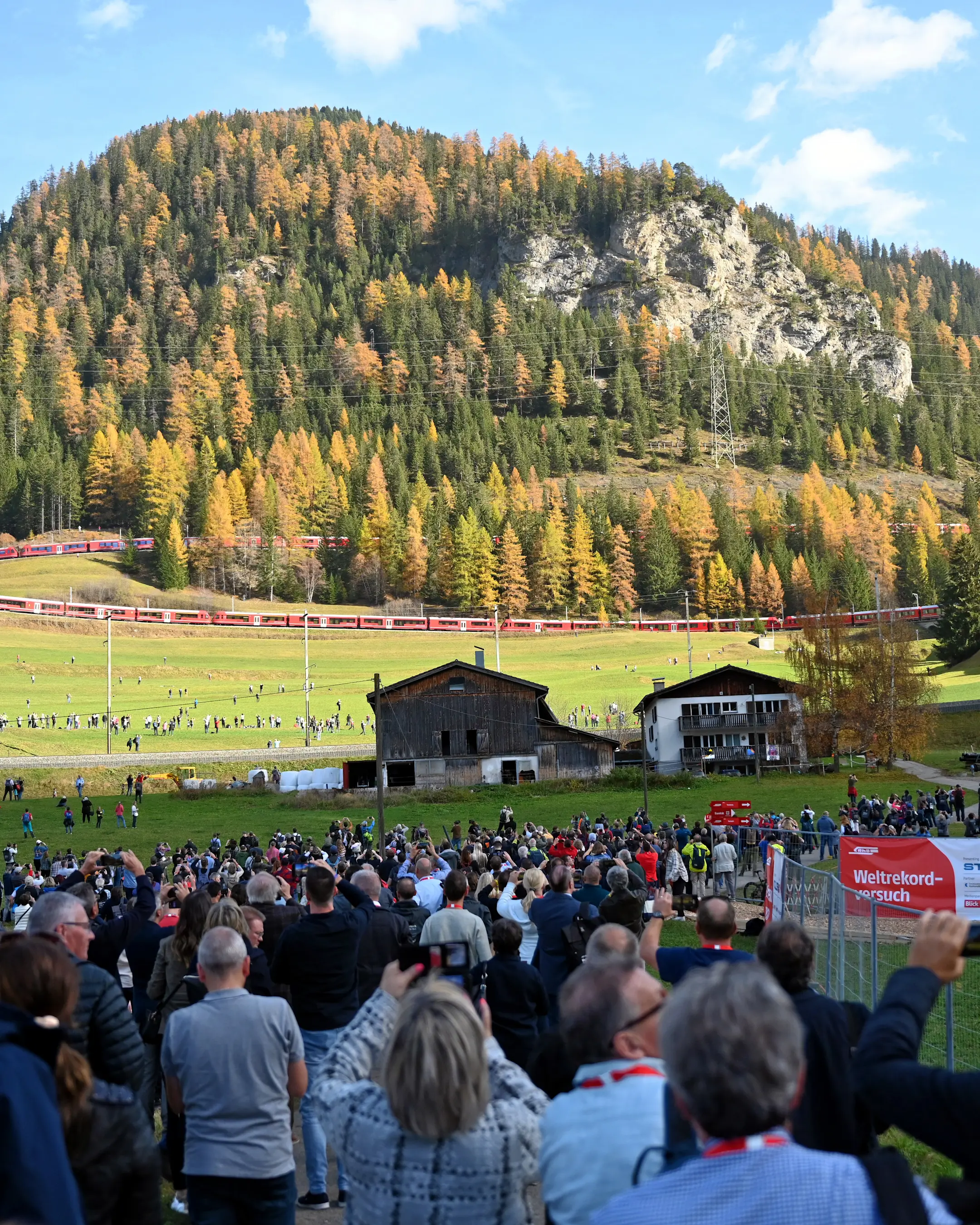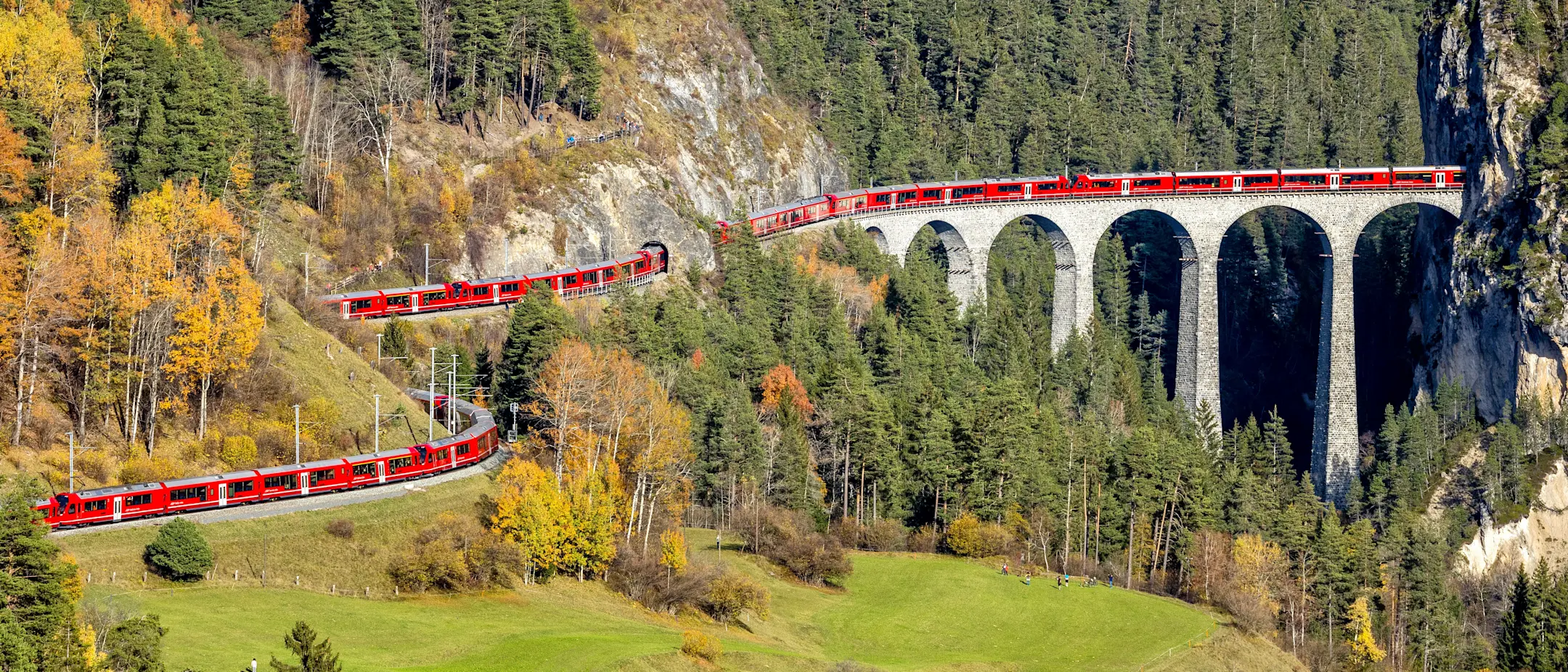On 29 October 2022, Rhaetian Railway wrote a piece of railway history: the world’s longest passenger train travelled on the UNESCO World Heritage route between Preda and the famous Landwasser Viaduct. An event that attracted thousands of railway fans to Bergün and the Albula Line and fascinated spectators around the world.

The record trip
29 October 2022
In sunny weather, thousands of people gathered along the Albula Line that Saturday afternoon. Along viaducts, bends and, in particular, at the railway festival in Bergün, they secured the best seats in good time to follow the world record attempt live.
The big moment came at 2.20 pm. The 1.91-kilometre-long train set off: out of the Albula Tunnel, where it had been coupled the night before, past Preda station and on along the UNESCO World Heritage route. Like an endless snake, the train pulled across the Albula Line through 22 tunnels and over 48 bridges. Twenty-five Capricorn railcars, 100 carriages, around 3,000 tonnes of steel and technology – controlled synchronously by seven train drivers.
At 3.30 pm, the train reached its climax: the spectacular crossing of the world-famous Landwasser Viaduct. Cheers broke out and cameras clicked: the world record had been broken. And shortly afterwards, when the official confirmation of the world record for the “longest narrow gauge passenger train” came from GUINNESS WORLD RECORDS™, the relief and excitement were immense.
This world record was more than just facts and figures. It was the result of passion, team spirit and innovation. And an experience that fascinated people both locally and around the world in front of their screens.

We are overjoyed to have set the world record. We had a wonderful railway festival in Bergün and, thanks to our dedicated partners, sponsors and an incredibly dedicated team, we were able to present ourselves around the world as a innovative mountain railway with our record-breaking journey.
Be inspired:
The world record in numbers
Route: 24,930 m from Preda to Alvaneu
Difference in altitude: 789.4 m (Preda 1,788.7 m above sea level → Alvaneu 999.3 m above sea level)
Structures: 48 bridges and 22 tunnels on the record-breaking route
Largest viaduct: Landwasser Viaduct (142 m long, 65 m high)
Longest tunnel: Greifenstein Tunnel (698 m)
Energy recovery: around 4,000 kWh of braking energy (recuperation)
Speed: approx. 30–35 km/h
Duration: around 1 hour
Train: 25 Capricorn compositions each of 4 carriages; total length: 1,906.375 m
Total weight: approx. 2,990 t
Communication: almost 2 km of field telephone (Civil Defence) for internal connection
Team on board: 7 train drivers and 21 technicians
Operation: Albula Tunnel closed to traffic for approx. 12 hours
The challenges
Never before has such a long passenger train travelled on a narrow-gauge line with tight bends, tunnels and viaducts in the high mountains. The trip made high demands in terms of technology and coordination.
Synchronous control of the train structure and handling of braking forces The 25 trains all had to accelerate or decelerate at the same time, although only four trains each could be controlled from the same driver’s cab. An electric circuit ensured that all trains braked at the same time if the trains needed to slow down suddenly. Due to the heavy weight of the train (2,850 t without passengers), very high forces were exerted on the infrastructure and the carriages. A separate intercom system on the train, trained train drivers and clear instructions ensured the desired result. In addition, special software was loaded for the record-breaking train and the mechanical braking power was reduced.
Recuperation and effects on grid load On the descent, the train was fully braked using electric recuperation. This generated electricity that was fed into the overhead contact line and could be used by other trains on the RhB network (as well as other railways in Switzerland and abroad). In addition, the surplus electricity could also be fed into the public grid using converters (e.g. in Bever). The major challenge was that the overhead contact line voltage could increase too much (usually 11,000 volts), as 25 trains in the same section were generating electricity synchronously. The overvoltage could not have been absorbed by individual systems connected to the traction current. Various tests were carried out to this end and measures were taken to ensure the record-breaking journey could take place (including limiting speed and acceleration, reducing recuperation using special software on the train, and preventive switching of systems to local grid power supply).
Connection of trains The individual four-unit Capricorn railcars were connected to a fully automatic coupling. Four trains were driven by each train driver. There was mechanical and pneumatic coupling between four Capricorn railcars each, but not electric coupling. For this purpose, additional safety control lines were laid between the trains.
Ensuring safety and availability of track and systems The track was closed to other trains for the record trip. The record-breaking train was sometimes longer than various block sections. The trip was controlled from the operations centre in Landquart. It had to be ensured that the signals, as well as the level crossings and customer information, were triggered at the right time.
Live media production The record trip was recorded by Blick in a live production and broadcast on various channels. For this purpose, a wide range of cameras were used from drones, in the driver’s cab and on the track and had to be processed in real time. This alone was a major and exciting challenge on a route with limited mobile coverage.

Partners and sponsors
There was a strong team behind the world record. A total of 15 renowned partners were on board for the world record. They underpinned the pioneering and innovative spirit that has always distinguished Switzerland as a railway and travel destination. Without the financial and technological support of the partners, the world record would not have been feasible. Stadler, which was also the manufacturer of the Capricorn railcars, acted as presenting partner.
The other engineering services were provided by ABB and Sersa as companies of the Rhomberg Sersa Rail Group. ABB stood for energy efficiency and Sersa for the construction and maintenance of the railway infrastructure. The main partners were complemented by Märklin, a specialist for model railways.
Presenting partner
Main partners
Partners
Media partners
Other partners
We would like to thank all our partners – for their courage, know-how and teamwork at the highest level.
